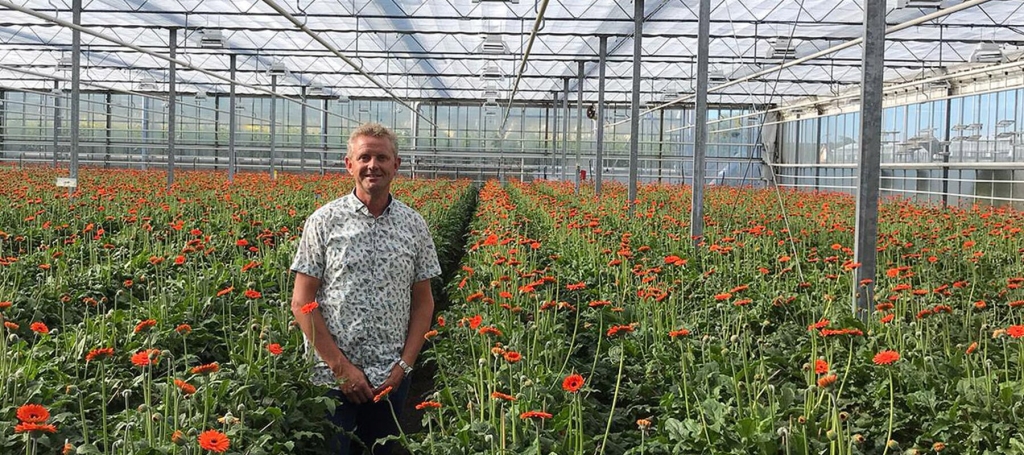Coatings soften the greenhouse climate; this provides an opportunity to change how the climate and watering are controlled. Two crop advisors discuss the principles that apply to tomatoes, gerbera and alstroemeria.
“The cooling force in a greenhouse is the crop itself. In the summer it is important to lower the plant’s temperature. To accomplish this you must keep the crop growing well so that it can cool itself through evaporation. A coating is an important aid in this respect,” says Marco van Noord of Horti-Consult International.
He advises tomato growers in North-West Europe. In this region, strong growing vegetative varieties can probably manage without a coating, he thinks. “But for a generative variety or a variety that is highly sensitive to blossom-end rot, I always recommend ReduFuse IR. Possibly supplemented with SprayChalk during extreme summer weather.”
The coating lowers the head temperature and ensures that the plant stays active and more resistant longer. Van Noord recommends that the coating be applied early in the spring; March-April is the best time. “In the beginning, the coating results in a somewhat lower greenhouse temperature. You need to take this into consideration. You can do this by setting the post-night temperature higher by 0.5-1°C in the morning. Furthermore, watering can be started up somewhat later during the initial weeks. If you normally start watering when radiation is 150 W, you can increase this to 200 W with a coating. This will make a difference of half an hour,” he says.
In a continental climate, extra cooling may be required in mid-summer. For example, by applying a SprayChalk layer on top of the diffuse layer. “As an emergency measure you can also close the movable shade screen, but at that point the heat is already inside the greenhouse. You should really keep the heat out in the first place. A coating is the best solution for this.”
NIGHT TEMPERATURE
High-pressure misting is gaining ground as a means of providing increased cooling. “The same situation applies here as well; the heat is already inside the greenhouse. This is why combining a coating with high-pressure misting is a good solution. This way the plant stays more active,” he says.
Furthermore, it is important to as much as possible take advantage of night-time to bring the temperature back down again. “That means you should extend the early night computer setting by opening the windows, albeit at a crack in order not to lose too much moisture. You should ensure that the greenhouse reaches the minimum temperature one hour prior to sunrise.”
The watering rule he applies is to multiply the light energy by a factor of 3 to 3.2. For example, for 2000 joules you need to supply 6 litres. “With a coating you can maintain a multiplication factor of 2.8 at the beginning. However, later on this difference disappears. In fact, with a coating you do not really supply less water over the course of the year. But your cooling capacity is greater, however.”

ALSTROEMERIA AND GERBERA
Crop advisor Marco de Groot of the Flori Consult Group also often advises his customers to use ReduFuse IR. He specialises in gerbera and alstroemeria, and works with growers in Europe and North America. “In the past, growers tended to use ReduHeat. However, the experience was inconsistent. Sometimes the crop was too short and the quality inferior for these specific crops. ReduSol was more effective in these situations. However, in recent years good results are being achieved with a ReduFuse IR coating,” he says.
Alstroemeria is a crop that has difficulty with evaporation and tends to close the skin pores fairly quickly in the afternoon. When a diffuse coating is applied, the skin pores stay open much longer. “You really need to take this into consideration. The plant evaporates more and as a result you must clearly provide more water, particularly by increasing the watering frequency. This means that the watering intervals become shorter.”
This equally applies to alstroemerias planted in the ground, as well as in a substrate. It is also necessary to use much shorter intervals for gerbera. For example, every 30 minutes, he says.
DIFFUSE LIGHT THROUGHOUT THE YEAR
When the crop evaporates better, the greenhouse temperature stays noticeably lower and the crop stays more active. “I am a big proponent of diffuse light and am managing the crop for the ‘Alstroemeria of the Future’, project managed by Wageningen University & Research. The usefulness of year-round diffuse light forms part of this project.”
The Flori Consult Group uses the PAR (Photosynthetic Active Radiation) Table to match light and temperature levels. “This is no different with coatings. On our recommendation, all of our customers have installed a PAR meter in their greenhouse in recent years and use it to regulate the temperature associated with the current light level. Measurements show that in case of variable weather you are always just a bit too late when you use a fixed screen. With a coating you are always on time. In case of variable weather the net PAR in the greenhouse is always greater with a coating than with a screen system. As a result, with ReduFuse IR you can maintain a somewhat higher temperature – on the basis of the PAR Table – than with a fixed screen system.”
